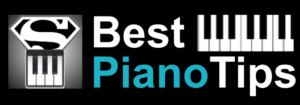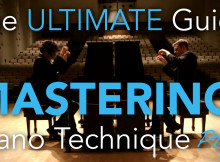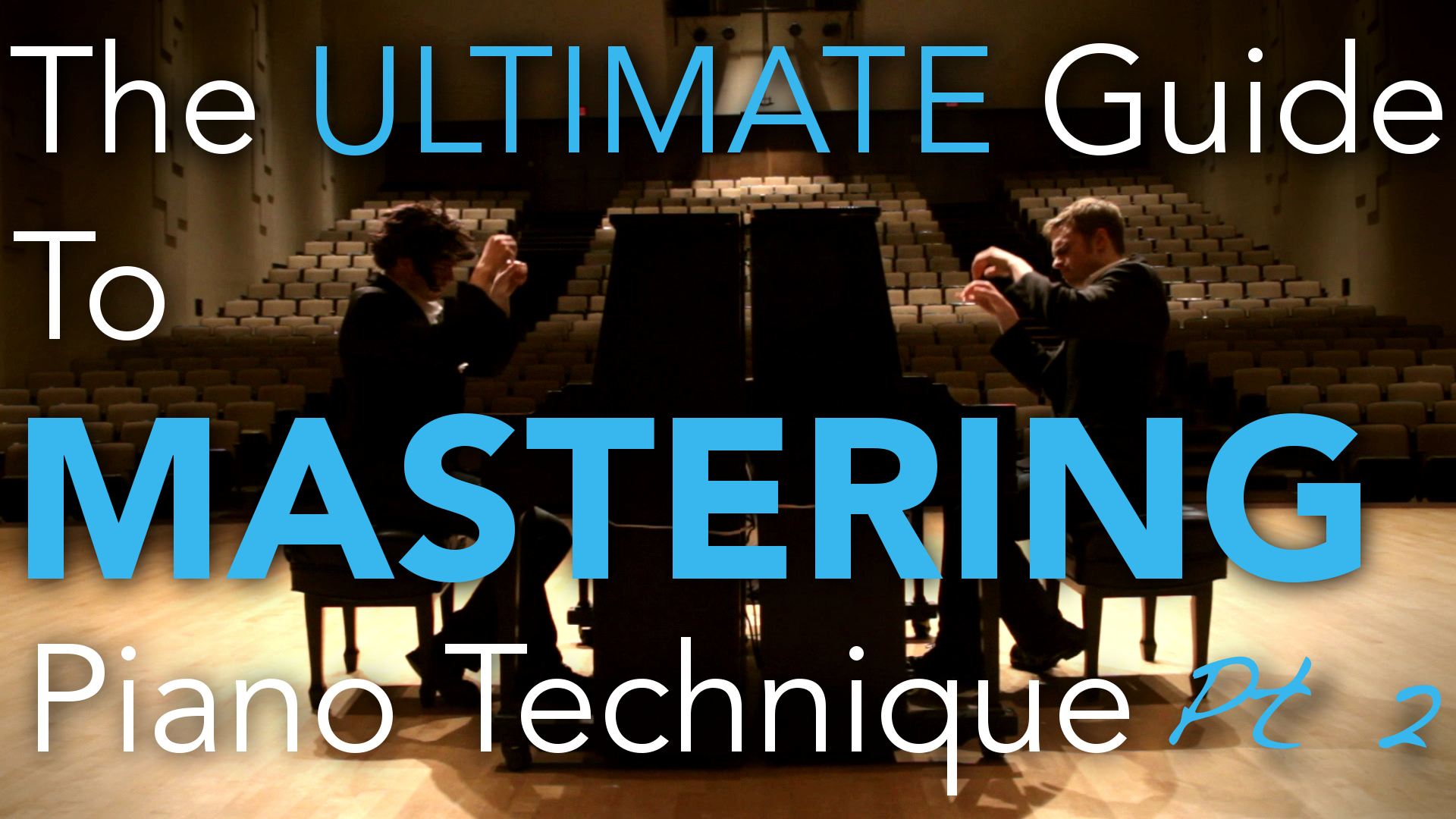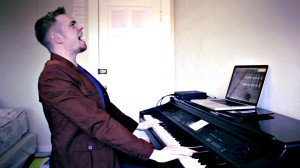Ok, so enough chit chat, time to get down to action.
Like anything else in life, you don’t get better at it by reading about it, you get better by doing it. So here’s my step-by-step systematic action plan to get some rock-solid piano technique. It only takes about 5 to 10 minutes a day, and it’s the exact method I used to get fast scales, arpeggios, broken chords, and octaves. If you haven’t read part 1 click here to read it, I’ll be referencing it throughout this lesson.
Step 1: Create Your Piano Technique Goal Sheet
Ok, so the first step is to create your goal sheet. Put this right smack dab in the front of your binder, it’s probably the number one indicator on how much you’re improving on piano. The more goals you cross off on this thing the more your piano technique will be improving.
You’re going to want to put the 4 drills (scales, arpeggios, broken chords, octaves) on the top and each key you want to learn on the side. If you want to learn classical music, or just want to be a very really well rounded pianist, include all the major keys and harmonic minor keys. Put them in the order of increasing accidentals, alternating Major and it’s relative minor (if you don’t know what that means don’t worry about it! You can just download the PDF and it’s all written out for you). If you only want to learn pop songs, just write the major keys through 3 sharps and flats (C G F D Bf A Ef). Those are the most common keys in pop music, and it would be better for you to just learn those keys really well than to spend a lot of time learning keys you’ll never use.
Now it’s time to set our “goal tempos”. This is the bpm (beats per minute) you want to be able to play each drill at (if you don’t have a metronome, GET ONE! For now just download the free app, but trust me you’re going to want a stand alone one). For your goal tempo, you want to set at a tempo that will challenge you, but not seem impossible. Try playing with different metronome tempos and feel out what tempo is just beyond your reach. This is going to be different for everyone, make your best guess and go with it!
Set the second goal tempo even faster. This is what I call your challenge tempo. Some keys are easier than others, so if you hit your goal early, you want another challenge to see if you can push yourself to the next level with that scale. It should be at a speed where you’re thinking to yourself “Man, it would be really tough to play it at that speed.” Don’t worry if you don’t hit the challenge tempos. Your first goal tempo is what you’re striving for, the second tempo is just icing on the cake!
I know this might seem very technical and anal, but I promise you if you use this practice mindset you’ll get a TON more out of your practice sessions.
Here’s the PDF download for the goal sheets:
Click Here for the Classical Goal Sheet
Click Here for the Pop Music Goal Sheet
Also, here’s PDF’s for the correct major and harmonic minor fingerings. Make sure you’re practicing with the right fingerings! If you’re not you’ll drill it in wrong to your muscle memory!
Harmonic Minor Scale Fingerings PDF
Step 2: Daily Workout
I like to think of my practice sessions as a workout. And every workout starts with a warmup. This is when you practice these drills, 5 to 10 minutes every day before you start your pieces.
Each week you’ll be practicing ONE key and TWO drills. So for example, week 1 you’ll be practicing C Major, and you might choose to work on scales and broken chords. One is your main drill, (the one you prioritize), and one is your secondary drill (the one you practice if you have extra time).
Btw I’d start out with scales for SURE as one of your two drills, since getting really good scales will help the rest of your playing dramatically. Here’s a free webinar on scale development if you’d like to get in-depth on that topic.
Start your stopwatch and practice your primary drill first. Don’t just mindlessly practice it, if you use practice strategies you can cut your learning time in half (btw to get some of my MOST USED practice strategies, sign up for the free Become a Piano Superhuman course here and scroll down to the lessons on “Accelerated Learning Techniques”). Practice for a while, and if you have extra time, practice your secondary drill as well.
The main reason for the secondary drill is to deal with frustration. I can tell you from experience there will be times where you get extremely frustrated trying to learn a certain scale. You’ll be drilling it over and over and making the same mistakes. That’s when you want to take a deep breath and switch to practicing your secondary drill. Practice that for a while, and when you go back to your main drill you’ll be surprised how much easier it is once your brain had a little break from it.
Once you hit a goal tempo, cross it off the list! Then make your secondary drill your main drill until that one reaches tempo too. If you get sick of the drills your working on, you can always switch it up and pick one of the other drills to work on for that day. The goal is to keep your motivation high, I think the number one reason people quit working on piano technique is they get frustrated when they can’t learn something. So when you feel that frustration starting to kick in, switch to a different drill for the rest of the day.
Step 3: Weekly Workouts

By the time you get to the 7th or 8th week, you’ll get in a grove. You’ll know exactly how much you’re able to learn in a week, and it gets exciting because you can look ahead and be really confident in your ability to cross off the rest of the boxes. It’s going to take you a while to cross everything off, but realize it’s a long term goal. Don’t stress out about crossing off everything fast, just know once your goal sheet is completed, your piano technique will be awesome and every song you learn from then on out will be much easier.
The goal sheet can be extremely motivating. I’d often find myself actually looking forward to practicing scales because I wanted to cross them off the list. I started doing scales to end my practice sessions sometimes when my motivation was especially high. Trust me, once you start seeing results you’ll actually be excited about practicing your piano technique!
A Final Note on Efficient Practice
One final note, since you’re only practicing 5 minutes a day, it is crucial you’re practicing as efficiently as possible. That means you want to be using practice strategies that are going to help you learn the drill in the shortest amount of time possible. Here’s a video lesson on arpeggio practice strategies, hopefully you’ll get the idea. Btw, this is a unlisted video from my premium Supercharge Your Piano Practice course, so please don’t share the link with anyone!
So there you have it, time to take ACTION. Go print off the PDF for your goal setting sheet now and set your goal tempos! Don’t wait until later, later becomes never. The sooner you put these steps into action the faster you’re going to improve your piano technique.
Happy practicing!
-Zach






Hello…I am impressed with your teaching style. I am a Senior Citizen retired…church is my outlet to sanity. Music… music… music. But African American Gospel music… How to learn chords with an impressive sound…which book do I need. of course playing by ear is key. My goal is playing chords for church with a big sound. I can read basic notes…everyone wants to jump into chords. Help.